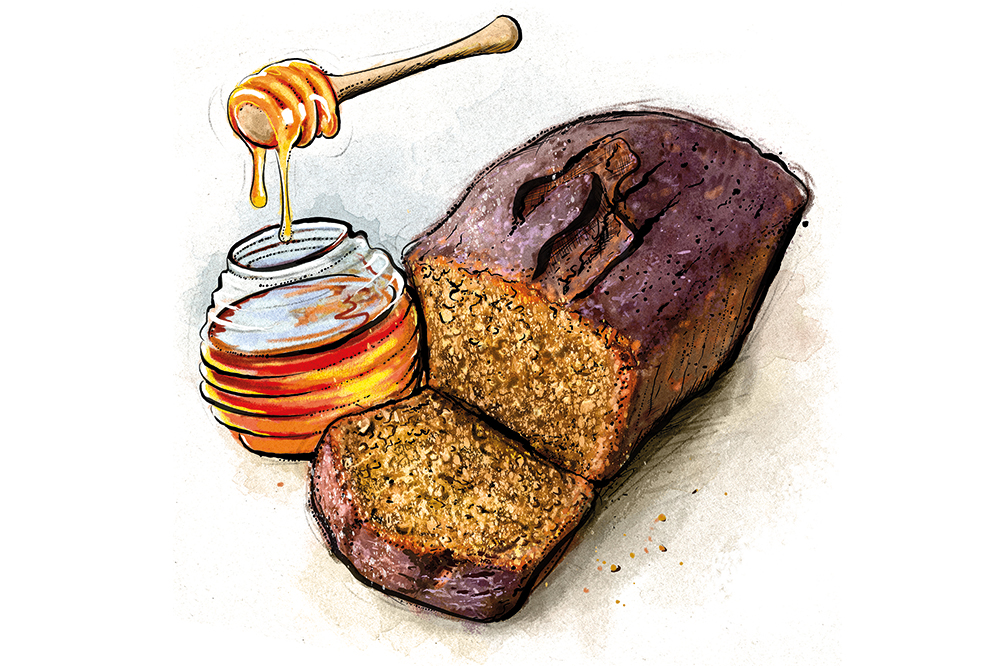I did not plan to cook a loaf cake when I embarked on concocting a traditional honey cake recipe. The original plan was to explore the Russian honey cake, or medovik, which dates back to the 19th century, and has a rich history. It is the War and Peace of the cake world: thick and a real undertaking. A long, careful assembly process, with up to a dozen layers of thin sponge – flavoured with honey and baked ever so briefly – interleaved with honey-flavoured buttercream, followed by a long chill, and then covered in more buttercream and cake crumbs. It is what we cookery writers like to euphemistically call ‘a project bake’.
Cooking with honey is a magical thing: no two honeys are truly the same
But as I set myself up in my kitchen, grabbing the jar of honey and smaller jars of spices, I realised that my heart wasn’t in it. I didn’t want something which would take two days to execute, that would be fridge-cold, and couldn’t just sit on my kitchen counter, tempting me whenever I walked by.
Perhaps one day I will come to you with a full-blown recipe for Russian honey cake, disavow my comments about the faffiness of the ‘proper’ version, and try to convince you that it is both surprisingly straightforward and worthwhile. But, for now, it’s not what I wanted. What I wanted instead was a squidgy sponge, something that hummed with spice and was loud with honey. A cake that I could eat standing up without a fork or plate, or could heat up in the microwave and serve with cream. I found myself reaching for a loaf tin.
Sometimes even the thought of creaming butter and sugar is a bit too much. Happily, it’s not called for here. This is a deliberately sticky cake, like an old-fashioned ginger cake, which means it’s made with melted butter and can all be mixed in one bowl.
But this is not your common-or-garden loaf cake. A honey cake is dark, bold and perfect for autumn, but its key ingredient means it also has nuance. Cooking with honey is a magical thing: no two honeys are truly the same, each being dependent on the exact flowers the bees have plundered. So the flavours and aromas that you find in the honey – whether clean, spicy, smoky or floral – will come through in the cake, too.
A few years ago I had a terribly fancy lunch in a terribly fancy restaurant, and diners were offered a tasting of five different honeys before choosing which they wanted baked into their madeleines – from the palest acacia to the mahogany buckwheat. The honey you choose to bake with will change the character of your cake.
Something similar is true of your choice of tea here, which is one of the reasons tea and honey make such good bedfellows. Whether it’s the zesty citrus of Earl Grey, the bold briskness of a Ceylon or the malty robustness of an English breakfast, all will enhance your cake with their natural charms.
The finished cake is sticky, damp and only improves over the days after baking. An extra lick of honey when it comes out of the oven and is still warm leaves it with a sticky glaze and ensures that the first thing that hits you is the blossom perfume of the honey, the star of the show.
I served the first slices as pudding just slightly warm, with crème fraîche and blueberry compote, and the last slices toasted and buttered. The slices in between? I ate them more quickly than I would like to admit, standing up, without plate or fork.
Serves 8
Takes 15 minutes
Bakes 45 minutes
- 100ml strong tea
- 200g butter
- 120g dark muscovado sugar
- 200g honey + 3 tbsp honey, to glaze
- 2 large eggs, beaten
- 250g self-raising flour
- ½ tsp ground cinnamon
- ½ tsp mixed spice
- ½ tsp fine salt
- Grease and line a 2lb loaf tin, and preheat the oven to 160°C.
- Make the strong tea with boiling water, and set aside to cool a little.
- Melt the butter, and stir through the honey and the sugar. Leave to cool for ten minutes until the mixture is warm rather than hot.
- Whisk the eggs into the mixture until thoroughly combined, fold through the flour, spices and salt, then stir in the tea.
- Pour into the lined loaf tin and cook for 45 minutes to an hour, until the cake is golden brown, risen and, when pressed gently with a finger, springs back.
- While still warm, brush generously with the extra honey to glaze, before leaving to cool completely.
To sign up for Olivia Potts’s bimonthly newsletter, which brings together the best of The Spectator’s food and drink writing, go to www.spectator.co.uk/oliviapotts
This article is free to read
To unlock more articles, subscribe to get 3 months of unlimited access for just $5






Comments
Join the debate for just £1 a month
Be part of the conversation with other Spectator readers by getting your first three months for £3.
UNLOCK ACCESS Just £1 a monthAlready a subscriber? Log in